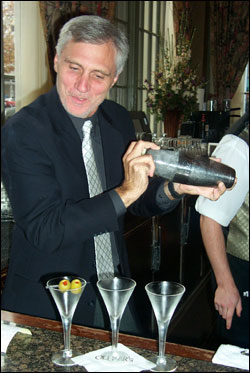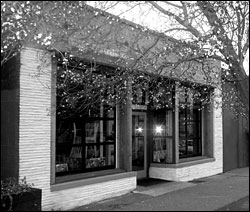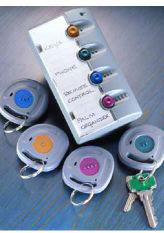Cocktail trends come and gowhat ever happened to the Horny Monkey?but one classy classic never falls out of vogue: the martini. Simple yet sexy, it’s the little black dress of mixed drinks. No other cocktail has the mystique of the so-called silver bullet. Mostly gin, with a dash of dry vermouth and only a little ice to smooth it out, the martini is also one of the strongest drinks in a bartender’s repertoire. It has inspired poetry from Dorothy Parker. It’s been immortalized by Hollywood, from The Thin Man’s Nick and Nora Charles to James Bond. A true mark of distinction: It has its own glass. It’s also the potion that’s kept our presidents blitzed for over a century (Franklin D. Rooseveltwho served Joseph Stalin his first martiniwas, famously, a martini lover. He was also famously bad at making them.)
Steve Burney, bar manager at Oliver’s Lounge (405 Olive Way, in the Mayflower Park Hotel; 206-623-8700), has made a career around the martini. Oliver’s has hosted their Martini Challenge eight times in the past 14 years. It may not be a coincidence that they’ve won the facetiously grand competition seven times. While Burney thinks Oliver’s makes a killer martini, he says their winning record is probably due mostly to their convenient placement as the last stop judges make on a tour of three martini bars.
He says the grandeur of the martini is somewhat playful. One drinks them because one wants to buy into the glamour. It may be the only habit most of us can afford to share with John D. Rockefeller, a martini man in his day and a regular at New York’s Knickerbocker Hotel bar in the early 1900s, the bar that’s generally recognized as the home of the modern martini.
Early forms of the martini were around long before Rockefeller’s time, though. There are numerous theories surrounding the drink’s origin. Many purists agree that it started in the San Francisco Bay area during the later gold rush days of the 1880s, but there’s disagreement over the details. Some say bartender Jerry “the Professor” Thomas invented the MartinezOld Tom gin, gum syrup, sweet vermouth, and a wedge of lemonin San Fran for a gold rusher on his way to the nearby town of Martinez. Others say it was born at the hands of a French immigrant bartender in a Martinez watering hole.
Whatever its origin, Burney says two events helped solidify the martini’s place as America’s Cocktail. After bartender Martini di Arma di Taggia popularized his modern martini at the Knickerbocker around 1912which, at one part vermouth to two parts gin, was actually sickeningly sweet by today’s barely-there-vermouth standardsits next boost came from Prohibition. When bars went underground, Burney says bathtub gin was the cheapest, easiest liquor to make at home. City drinkers became gin drinkers by necessity. The other influential event was the invention of the cocktail hour by the Cunard Trans-Atlantic luxury cruise line. Prohibition wasn’t an issue on the seas, and Cunard chose to serve the martini for its refined image.
THE MARTINI’S association with Rat Pack-era class and affluence has been perpetuated in film. After its popularity waned somewhat in the ’70s in the shadow of crazier, more colorful disco cocktails, Smirnoff’s market-ing deal with the James Bond movies introduced the martini to a new generation of young adultsthis time with vodka replacing gin.
This is where the purists scream. A martini without gin, many say, is not a martini at all (though Burney says that even at Oliver’s, about 40 percent of martini drinkers request vodkait’s flavorless, odorless, and therefore more widely palatable than gin). And even those who favor gin argue over which type is truer to the martini form: London Dry (such as Bombay Sapphire and Tanqueray Ten, two of Burney’s favorites) or other gins. The vodka-gin debate isn’t the only rift in martini wisdom. Some maintain that martinis should not be shaken for fear of “bruising” the ginwatering it downwhile others, like Burney, insist on shaking them vigorously. “It smooths it out for today’s tastes,” he says, rounding off some of the bite while also creating an attractive layer of ice crystals across the top of the drink.
Most purists agree that a true martini is garnished with a green olive or two, but some prefer to swap the olives for pearl onions and call it a “Gibson.”
Regardless of how it’s decorated, the true mark of a good martini is the gin-vermouth ratiothe more vermouth, the sweeter the martini. But people who like their cocktails sweet don’t have any business drinking martinis. Most aficionados prefer them bone dry. Oliver’s serves them extra, extra dry, adhering to the in-and-out method developed by Richard Nixon and Bebe Rebozo: The glass is first treated with a dry vermouth residue; after that, it’s all gin. No wonder they’re the reigning champs.







